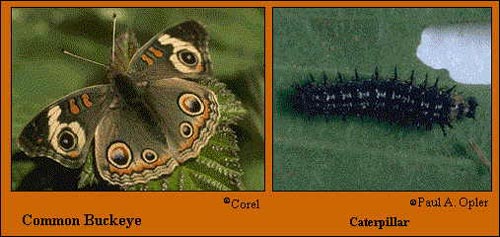Buckeye (Junonia coenia)

Identification: Upperside is brown. Forewing with 2 orange cell bars and 2 eyespots; part of white subapical band appears in the largest, lower eyespot. Hindwing has 2 eyespots; upper one is largest and contains a magenta crescent. Underside of hindwing is brown or tan in the wet season (summer) form and rose-red in the dry season (fall) form.
Life history: Males perch during the day on low plants or bare ground to watch for females, flying periodically to patrol or to chase other flying insects. Females lay eggs singly on leaf buds or on upperside of host plant leaves. Caterpillars are solitary and eat leaves. Caterpillars and adults overwinter but only in the south.
Flight: Two to three broods from May-October, throughout the year in the Deep South.
Caterpillar hosts: Plants from the snapdragon family including snapdragon (Antirrhinum) and toadflax (Linaria); the plantain family including plantains (Plantago); and the acanthus family including ruellia (Ruellia nodiflora).
Adult food: Favorite nectar sources are composites including aster, chickory, gumweed, knapweed, and tickseed sunflower. Dogbane, peppermint, and other flowers are also visited.
Habitat: Open, sunny areas with low vegetation and some bare ground.
Range: Resident in the southern United States and north along the coasts to central California and North Carolina; south to Bermuda, Cuba, Isle of Pines, and southern Mexico. Adults from the south's first brood migrate north in late spring and summer to temporarily colonize most of the United States and parts of southern Canada.
Comments: The eyespots may be used to scare away predators.
Conservation: Not required.
Management needs: None reported.
The Nature Conservancy Global Rank: G5 - Demonstrably secure globally, though it may be quite rare in parts of its range, especially at the periphery.